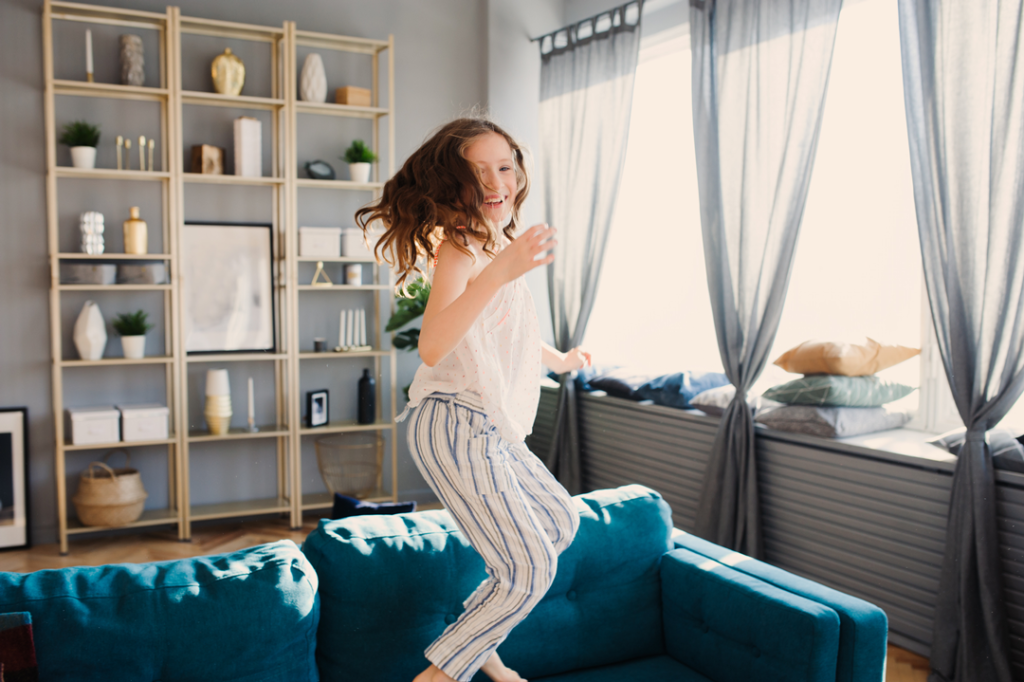[Don’t] Stop Jumping on the Couch
The Benefits of Physical Activity for Our Youth
Dr. Rhianna Wickett, PT, DPT, CSCS
Elevate Performance, Rapid City
We like to provide the best for our children. We make plans to give them a great education and maybe send them to college, teach them values and work ethic, and we try to set them up for success throughout life. But—did you know you are planning for your child’s long-term health before they even reach high school?
Most parents have told their child to stop jumping on the couch or not to jump off the last three steps of the stairs, with something like… “You’re going to hurt yourself!” Is it possible, though, that this jumping and activity may be exactly what our young ones need in order to protect themselves as they reach adulthood and into their later years of life? The research says YES! The benefits our children receive from physical activity into their teens will decrease their risk of osteoporosis, fractures, and chronic disease later in life, such as obesity, cardiovascular disease, and diabetes. 1,2
Bone Mass
In general, the health and strength of our bones is called our bone mass. It is impacted most by physical activity, nutrition, and calcium intake. Age-related bone loss is a normal part of the aging process (which can be 1% per year!), so it is important to build up the “bank account” of bone mass early in life. Peak bone mass (PBM) is the greatest bone mass one will have throughout his or her lifespan and is one of the strongest predictors of osteoporosis and fractures later in life. Sixty percent of the bone mass we’ll have throughout our life is formed during puberty.1 For most of us, our peak bone mass is achieved by ages 25-30!1 This means that for our young children, we need to help them grow and promote this bone development in the first two decades of life. But HOW? One of the easiest ways to is to exercise! (And it’s FREE!)
Physical Activity
Promoting strong bones doesn’t have to be complicated, and exercise doesn’t need to be boring! Bones get stronger from the forces placed on them by our muscles. This can be playing, running, jumping, and resistance training, which have the greatest impact on the hip and low back bone health.2 A higher bone mass has been reported in active children, versus those that are sedentary, but it doesn’t just stop there. The bone strength we build from physical activity into teenage years has been shown to maintain throughout adulthood! Higher-intensity weight bearing exercises such as gymnastics, ballet, and weight lifting provide the greatest bone mass increase. However, encouraging frequent running, playing, and jumping is effective for our younger children to build the bone mass they need. Although you likely don’t want to encourage jumping off the couch with visitors around, running and jumping from low heights regularly, such as off play equipment, will help build enough bone and muscular strength to prevent injuries later in life!
Nutrition
In addition to physical activity, nutrition plays a key role in our children’s bone and overall health. We are the biggest role models in our children’s activity and nutrition choices, so we need to be teaching healthy habits early on. Encouraging healthy snacks that are high in calcium and protein can have a positive impact on our children’s bone health. Most families are busy and on-the-go, so packing snacks with us is a great opportunity to get the proper nutrition. Great snacks high in protein and calcium are: almonds, cheese, yogurt (but check the sugar content!), bananas, veggies, and peanut butter. For pre-packaged foods, be sure to read the nutrition labels. Some products are packed with added sugars, which has been shown to have negative affects on bone health.3
Fun For the Whole Family!
So how much of this activity do our children need to see these benefits for both their bones, muscles and cardiovascular health? Studies have shown greater bone strength in children after just 20 minutes of high intensity activity including jumping three times per week. For overall health, the CDC recommends our children get 60 minutes of moderate to high-intensity activity at least three times per week.
Teaching our kids to exercise doesn’t have to mean strenuous workouts or hitting the gym. It also doesn’t need to take huge blocks of time. You can simply think of it as leading a healthy lifestyle and use family time to get active or outdoors and have fun together! Some great ideas to increase your family’s activity are:
- Take evening walks after dinner
- Play a game of tag
- Hopscotch: improve balance, coordination, and build bone strength at once!
- Go on a bike ride
- Jump Rope
- Make an obstacle course: Stay active indoors even on a rainy day!
- Follow the Leader: add jumping, squatting, running for a full body workout!
- Game Night: Take a break from the board games and get active with games like softball, volleyball, or basketball
So the next time your child is jumping and running, just remember – they’re building bone mass!
References:
- Keith J. Loud, MDCM, MSc; Catherine M. Gordon, MD, MSc. Adolescent Bone Health. Arch Pediatr Adolesc Med. 2006;160:1026-1032
- Fuchs R, Bauer J, Snow C. Jumping Improves Hip and Lumbar Spine Bone Mass In Prepubescent Children: A Randomized Controlled Trial. J Bone Miner Res. 2001; 16:148-156.
- 3. Milne DB, Nielsen FH. The Interaction Between Dietary Fructose and Magnesium Adversely Affects Macromineral Homeostasis in Men. J Am Coll Nutr. 2000 Feb; 19(1):31-7.


